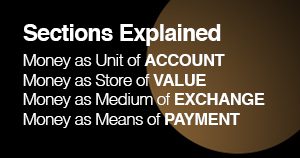In theory, micropayments could be one of the most disruptive technologies of all. But will a future of instant, free small money transfers ever arrive?
The micropayment promise
The designers of the original World Wide Web expected native digital payments to be part of the infrastructure. But this part of the internet never arrived, and it’s now nearly three decades overdue.
Micropayments could be revolutionary
A functioning system for micropayments—transactions of less than $/£/€1, including fractions of a cent or penny—could be revolutionary.
It would replace subscription fees of all kinds, allowing users to pay for the exact amount of services they consume.
Allowing content consumers to pay content producers directly could encourage an explosion of peer-to-peer business activity and creativity.
Micropayments could also rewrite the rules of work and corporate organisation, allowing contractors or employees to be paid income streams in real time for every second of work that they log.
“A central flaw in today’s internet, one that props up all sorts of wrongs”
Most importantly, micropayments would flatten power structures across the digital economy, challenging the advertising-driven business models of monopolistic internet firms, with their alarming knock-on effects on privacy and democracy.
“The lack of a seamless micropayment system is a central flaw in today’s internet, one that props up all sorts of wrongs,” sociologist Zeynep Tufekci wrote in Wired magazine earlier this year.
Pricing and mental challenges
There are two reasons why micropayments have yet to take off, says financial historian and blogger JP Koning.
One is the stranglehold of existing payments networks like Visa and Mastercard, which have pricing structures that make small payments uneconomical.
Let’s say a writer wants to sell readership access to a short story for $0.25, says Koning. If you try doing that using Visa, you’ll face a 0.05 percent charge, plus a flat $0.21 fee for each small debit card transaction, making the whole transaction unviable.
As long ago as 2007, Bill Gates, CEO of Microsoft, was blaming the high per-item clearing and settlement fees of the card networks for the absence of a viable micropayment system.
Card providers counter that their minimum fees help cover the costs of fraud prevention, errors and chargebacks.
“Micropayments are a nuisance—and so we don’t make them”
The second reason for the lack of progress in micropayments may be more fundamental, says Koning.
Citing Nick Szabo, a computer scientist and cryptocurrency pioneer, Koning says that we may all have limited mental capacity for processing large volumes of small transactions.
“For larger amounts, say $20, the seconds spent puzzling out whether to make a $20 purchase is time well spent. Making the wrong decision means wasting the $20. But no one wants to waste brain cycles estimating whether 2.3 cents is too much to pay for short story. Micropayments are a nuisance—and so we don’t make them,” says Koning.
Native micropayments on social networks
But recent developments make a functioning global micropayments system seem one step closer to reality.
One is the rapidly growing interest of internet giants and tech firms in small-sized payments.
“Banks and other payment service providers haven’t provided a viable micropayment service, because they can’t do it economically,” says Dave Birch, a director of Consult Hyperion and payments expert.
“But we are now starting to see alternatives,” says Birch.
“Take Apple’s new credit card,” he says, “which gives you cashbacks in Apple Cash, rather than in money. People can then use their balances to pay for purchases in the app store, and so on. More importantly, the marginal cost to Apple of transferring Apple Cash from one account to another is approximately zero.”
“Then along comes Facebucks,” says Birch, referring to Facebook’s native digital payment scheme, reportedly due to arrive next year.
“You can easily see an ecosystem growing up around Facebook, where one user says to another, ‘You can read my fashion blog for a Facebuck’,” says Birch.
“All of a sudden, inside the Facebook ecosystem, micropayments become economically viable again.”
“Facebook stands alone in the depth and variety of network effects they’ve built”
The dominant position of Facebook across its three native messaging systems, Messenger, WhatsApp and Instagram, which have over 2bn combined users, seems to make the prospect of native digital payments even more attractive for Mark Zuckerberg, the firm’s CEO.
“We don’t think most people really understand Facebook yet,” says James Currier, a managing partner at NfX, a venture capital firm.
“Facebook stands alone in the depth and variety of network effects they’ve built, even though most go undetected,” says Currier.
The cryptocurrency alternative
Others are placing their bets on micropayment schemes that use cryptocurrencies.
Bitcoin, for example, is divisible into units called satoshis, with a hundred million satoshis making up one bitcoin. At current fiat exchange rates, that makes one satoshi equivalent to around $0.00008—easily small enough for uses in micropayment schemes.
However, at current fee rates, transferring small numbers of satoshis across the main bitcoin network, or ‘blockchain’, is economically unviable: on 31 May, the cost of recording a bitcoin transaction in the blockchain was around $4, according to blockchain.info. Reflecting that cost, the average bitcoin transaction size is now around $3,300.
Instead, those wishing to make small-value payments in bitcoin can use the Lightning network, a separate payments layer.
“Lightning makes web-based micropayments very user-friendly”
Instead of recording all bitcoin transactions on the blockchain, Lightning requires its users to set aside a certain volume of bitcoin in so-called payment channels.
Any two users linked by a channel can then transact as often as they wish for a near-zero cost and up to the value of the bitcoin allocated in this way. Once a payment channel is no longer needed, the final balance is broadcast to the overall bitcoin network, securely settling the funds on the blockchain.
However, although it only launched last year, the Lightning network remains small: on 31 May, it had 8,591 nodes and a total network capacity of 1,011 bitcoin ($8.4m). Nevertheless, those using it are optimistic about its prospects.
“Lightning is extremely fast and cheap. Coupled with the Joule browser extension or a compatible mobile wallet, it makes web-based micropayments very user-friendly,” says Matt Odell, a cryptocurrency commentator and co-founder of finalmessage.io.
Lightning nodes set a default fee of 1 satoshi per transaction, plus a percentage fee of 0.000001 satoshi per satoshi sent.
“I imagine fees will go up a bit as the network matures, but the way Lightning fees are structured, based on amount being sent rather than size in bytes, should mean micropayments will remain practical regardless,” says Odell.
Could the Lightning network ever match a micropayments system run by an internet giant like Facebook, with over 2bn captive users?
That goal will require the involvement of professional liquidity providers, says Bitmex, a peer-to-peer trading platform, with a potential knock-on effect on the economics of the network.
“The Lightning network can easily scale to many multiples of Bitcoin’s current on-chain transaction volume, all based purely on hobbyist liquidity providers,” Bitmex wrote in a blog.
“However, if the network is to reach the scale many Lightning advocates hope, it will need to attract liquidity from yield-hungry investors. Should that occur, the network may experience significant changes in fee market conditions as the investment climate changes over time.”
“Blockchain micropayments offer a way for people to pay for privacy on the internet”
Some blockchain enthusiasts believe that a functioning micropayment system could fundamentally alter the internet’s power structures and hand a censorship-resistant technology back to users.
“Blockchain micropayments offer a way for people to actually pay for privacy on the internet. Right now, other than virtual private networks (VPNs), it’s not that easy to do,” says Dave Hrycyszyn, a technologist and systems designer.
A functioning system for small peer-to-peer transactions over the internet has long been a pipe dream. But a recent spurt of investment and development activity suggests that the battle to crack micropayments is finally hotting up.
Sign up here for New Money Review’s monthly content updates









